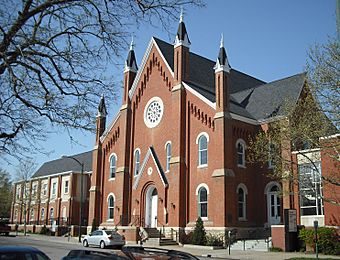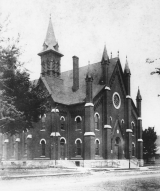Plymouth Congregational Church (Lawrence, Kansas) facts for kids
Quick facts for kids |
|
|
Plymouth Congregational Church
|
|

The church in 2011
|
|
| Location | Lawrence, Kansas |
|---|---|
| Built | 1868-1870 |
| Architect | John G. Haskell |
| Architectural style | Victorian with Gothic and Romanesque Revival characteristics |
| NRHP reference No. | 09000674 |
| Added to NRHP | September 2, 2009 |
The Plymouth Congregational Church in Lawrence, Kansas, is a special place with a long history. It is part of the United Church of Christ. This church was started in 1854. That was just a few months after the Kansas Territory was opened for people to settle there. The church building you see today was built in 1870. It is so important that it is listed on the National Register of Historic Places. This means it's a historic landmark!
The person who designed this church was John G. Haskell. He was also one of the architects who helped design the Kansas State Capitol building.
Contents
History of the Church
Starting in the Kansas Territory
The Kansas–Nebraska Act opened the Kansas Territory for settlement on May 30, 1854. Reverend Samuel Y. Lum came from New York to start the first church in the new city of Lawrence, Kansas. This was also the first church in the entire Kansas Territory. Before he arrived, settlers held their own sermon readings.
The very first service for Plymouth Congregational Church was on October 1, 1854. Reverend Lum held it in a simple "hay tent" or mudbrick boarding house. The people who attended were settlers who had traveled from New England.
The Stone Church Era
In 1857, Reverend Richard Cordley became the church's pastor. The church moved into its first permanent building, which they called the "Stone Church." This building was finished in 1862.
Reverend Cordley was an abolitionist. This means he was against slavery. He strongly supported the "free state" movement in Kansas. This movement wanted Kansas to become a state where slavery was not allowed.
During the American Civil War, a terrible event happened. Pro-Confederate forces, led by William Quantrill, attacked Lawrence in 1863. This event is known as the Lawrence Massacre. Several church members were killed. Reverend Cordley's home was burned down, but the church building itself was not damaged. Cordley was very important for writing down what happened during these early days in Kansas.
The Brick Church Building
The church building used today is often called "The Brick Church." It was designed by architect John G. Haskell. He also designed other churches and schools, along with parts of the Kansas State Courthouse.
Building the church started in 1868 and finished in May 1870. It cost $45,000 to build. The beautiful windows in the main worship area were made in England. Services have been held regularly in this building since 1870.
In 1916, a part called the "Parish House" was added to the church. A fire damaged it in 1955, but it was rebuilt and made larger. More updates and repairs were done to different parts of the church in 1992 and 2001.
On July 16, 2009, the Kansas Historical Society suggested that the building be added to the National Register of Historic Places. It was officially listed on September 2, 2009. The building's style is a mix of Victorian architecture, with features from Gothic architecture and Romanesque Revival architecture.
Important People from the Church
Many notable people have been members of Plymouth Congregational Church:
- Barbara Ballard - She has been a member of the Kansas House of Representatives since 1993.
- Paul Davis - He was a member of the Kansas House of Representatives from 2009 to 2015. He also ran for governor of Kansas in 2014.
- Tom Holland - He has been a member of the Kansas Senate since 2009. He ran for governor of Kansas in 2010.
- Alan Mulally – He was the president of the Ford Motor Company. He said that the late Reverend Dale Turner was a "mentor and an inspiration" to him. Reverend Turner later moved to a church in Seattle, Washington. Mulally stayed in touch with him after moving to Seattle to work at Boeing.
See also
Images for kids





